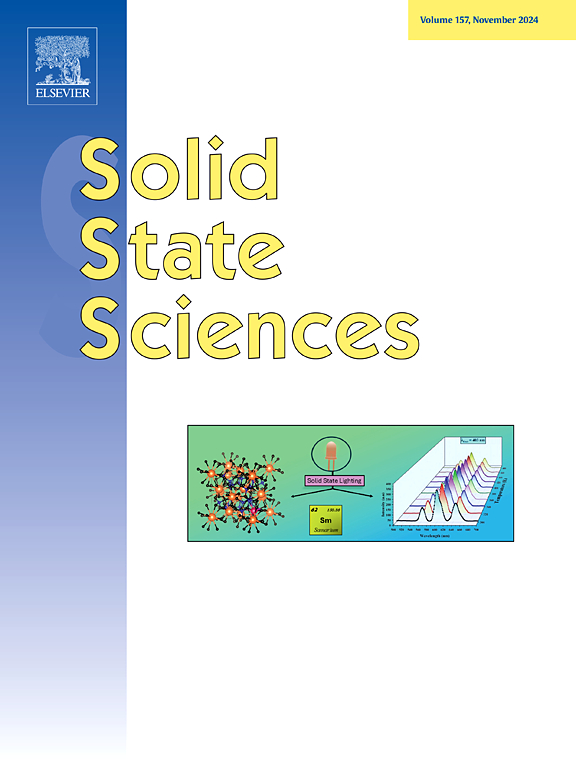Characterization of (HfTiZrTaM)B2 (M=Mn/Mo/W/Cr) high entropy diboride ceramics with five/six components prepared via powder metallurgy
IF 3.4
3区 化学
Q2 CHEMISTRY, INORGANIC & NUCLEAR
引用次数: 0
Abstract
This study shows the possibility of synthesizing five/six constituent high entropy (HfTiZrTaM)B2 (M=Mn/Mo/W/Cr) diboride ceramics via mechanical alloying (MA) assisted spark plasma sintering (SPS). Firstly, metal borides as starting materials were synthesized in-house via mechanochemical synthesis (MCS) and leaching using optimum conditions. Secondly, metal borides were mixed in equimolar ratios to consist of five or six components, and then MA was used to hybridize the mixture for 6 h. SPS (2000 °C, 30 MPa) was used to convert the hybridized powders into densified structures. The compositional, microstructural, physical, mechanical and thermal analyses were conducted. Based on the results, the main HEB phase and low amount of (Hf, Zr) oxides were detected. Also, there was a secondary phase in the (HfTiZrTaCrW)B2 composition. Approximately 8.19 g/cm3 and 6.72 g/cm3 were found as the highest and the lowest Archimedes’ densities for the (HfTiZrTaCrW)B2 and (HfTiZrTaCrMo)B2 samples, respectively. (HfTiZrTaCrMn)B2 had the lowest hardness value nearly 22 GPa, and (HfTiZrTaCrW)B2 had the highest hardness value at about 24 GPa. (HfTiZrTaCrW)B2 had the highest wear rate (∼6.85x10−6 mm3/Nm), and (HfTiZrTaCrMo)B2 had the lowest wear rate (∼5.95x10−7 mm3/Nm). Based on the thermal tests, the highest weight gain up to 1100 °C was found for the (HfTiZrTaCrMn)B2 sample

粉末冶金法制备(HfTiZrTaM)B2 (M=Mn/Mo/W/Cr)五/六组分高熵二硼化物陶瓷的表征
本研究证明了利用机械合金化(MA)辅助火花等离子烧结(SPS)制备五/六组分高熵(HfTiZrTaM)B2 (M=Mn/Mo/W/Cr)二硼化物陶瓷的可能性。首先,以金属硼化物为原料,采用机械化学合成(MCS)和最佳浸出条件,在室内合成金属硼化物。其次,将金属硼化物按等摩尔比混合成五种或六种组分,然后用MA杂化混合物6 h,用SPS(2000℃,30 MPa)将杂化粉末转化为致密结构。对其进行了成分、显微组织、物理、力学和热分析。在此基础上,检测到主要的HEB相和少量的(Hf, Zr)氧化物。此外,在(HfTiZrTaCrW)B2组合物中还存在一个次级相。(HfTiZrTaCrW)B2和(HfTiZrTaCrMo)B2样品的阿基米德密度最高约为8.19 g/cm3,最低约为6.72 g/cm3。(HfTiZrTaCrMn)B2的硬度最低,接近22 GPa, (HfTiZrTaCrW)B2的硬度最高,约为24 GPa。(HfTiZrTaCrW)B2的磨损率最高(~ 6.85x10−6 mm3/Nm), (hftizrtacro)B2的磨损率最低(~ 5.95x10−7 mm3/Nm)。根据热测试,发现(HfTiZrTaCrMn)B2样品在高达1100°C时的重量增加最大
本文章由计算机程序翻译,如有差异,请以英文原文为准。
求助全文
约1分钟内获得全文
求助全文
来源期刊

Solid State Sciences
化学-无机化学与核化学
CiteScore
6.60
自引率
2.90%
发文量
214
审稿时长
27 days
期刊介绍:
Solid State Sciences is the journal for researchers from the broad solid state chemistry and physics community. It publishes key articles on all aspects of solid state synthesis, structure-property relationships, theory and functionalities, in relation with experiments.
Key topics for stand-alone papers and special issues:
-Novel ways of synthesis, inorganic functional materials, including porous and glassy materials, hybrid organic-inorganic compounds and nanomaterials
-Physical properties, emphasizing but not limited to the electrical, magnetical and optical features
-Materials related to information technology and energy and environmental sciences.
The journal publishes feature articles from experts in the field upon invitation.
Solid State Sciences - your gateway to energy-related materials.
 求助内容:
求助内容: 应助结果提醒方式:
应助结果提醒方式:


